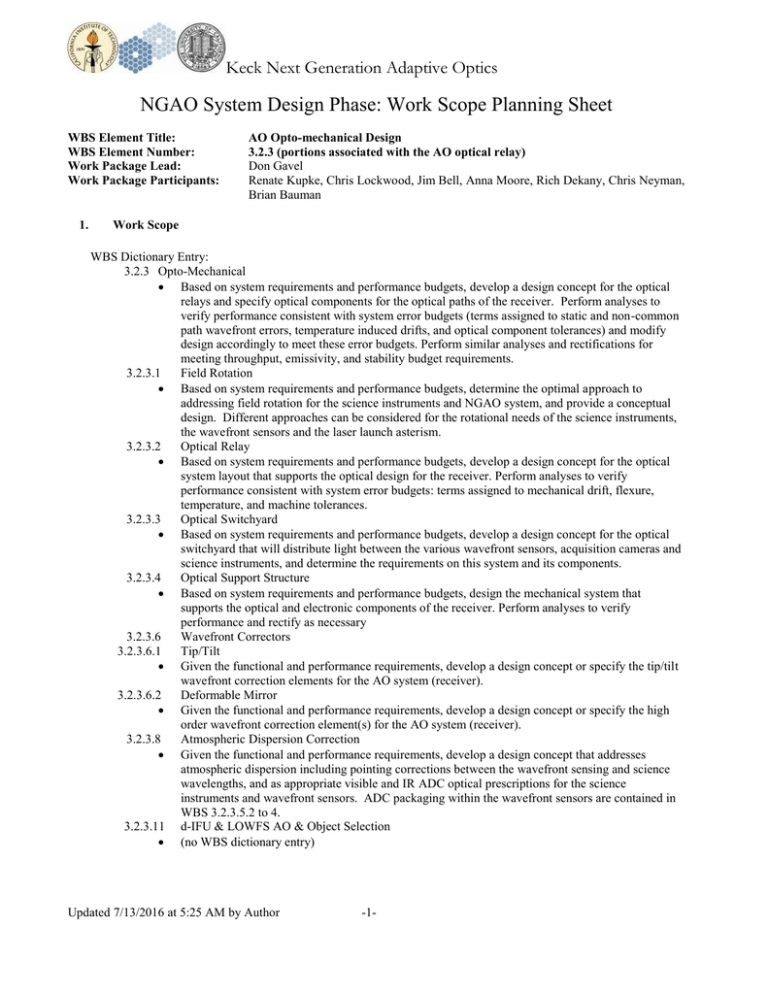NGAO System Design Phase: Work Scope Planning Sheet
advertisement

Keck Next Generation Adaptive Optics NGAO System Design Phase: Work Scope Planning Sheet WBS Element Title: WBS Element Number: Work Package Lead: Work Package Participants: 1. AO Opto-mechanical Design 3.2.3 (portions associated with the AO optical relay) Don Gavel Renate Kupke, Chris Lockwood, Jim Bell, Anna Moore, Rich Dekany, Chris Neyman, Brian Bauman Work Scope WBS Dictionary Entry: 3.2.3 Opto-Mechanical Based on system requirements and performance budgets, develop a design concept for the optical relays and specify optical components for the optical paths of the receiver. Perform analyses to verify performance consistent with system error budgets (terms assigned to static and non-common path wavefront errors, temperature induced drifts, and optical component tolerances) and modify design accordingly to meet these error budgets. Perform similar analyses and rectifications for meeting throughput, emissivity, and stability budget requirements. 3.2.3.1 Field Rotation Based on system requirements and performance budgets, determine the optimal approach to addressing field rotation for the science instruments and NGAO system, and provide a conceptual design. Different approaches can be considered for the rotational needs of the science instruments, the wavefront sensors and the laser launch asterism. 3.2.3.2 Optical Relay Based on system requirements and performance budgets, develop a design concept for the optical system layout that supports the optical design for the receiver. Perform analyses to verify performance consistent with system error budgets: terms assigned to mechanical drift, flexure, temperature, and machine tolerances. 3.2.3.3 Optical Switchyard Based on system requirements and performance budgets, develop a design concept for the optical switchyard that will distribute light between the various wavefront sensors, acquisition cameras and science instruments, and determine the requirements on this system and its components. 3.2.3.4 Optical Support Structure Based on system requirements and performance budgets, design the mechanical system that supports the optical and electronic components of the receiver. Perform analyses to verify performance and rectify as necessary 3.2.3.6 Wavefront Correctors 3.2.3.6.1 Tip/Tilt Given the functional and performance requirements, develop a design concept or specify the tip/tilt wavefront correction elements for the AO system (receiver). 3.2.3.6.2 Deformable Mirror Given the functional and performance requirements, develop a design concept or specify the high order wavefront correction element(s) for the AO system (receiver). 3.2.3.8 Atmospheric Dispersion Correction Given the functional and performance requirements, develop a design concept that addresses atmospheric dispersion including pointing corrections between the wavefront sensing and science wavelengths, and as appropriate visible and IR ADC optical prescriptions for the science instruments and wavefront sensors. ADC packaging within the wavefront sensors are contained in WBS 3.2.3.5.2 to 4. 3.2.3.11 d-IFU & LOWFS AO & Object Selection (no WBS dictionary entry) Updated 7/13/2016 at 5:25 AM by Author -1- Title Date 2. Requirements: Need additional input on: (these have been identified as specifications that are not presently part of the available inputs) o Requirements on insertable calibration unit o Field of view requirements of large relay, and performances on those fields o Accuracy requirements for the ADC o Is support of OSIRIS a requirement that must be met by the optical switchyard? 3. Inputs: Functional requirements documents NGAO System Architecture Definition (KAON 499) Output of Optical Relay and Field Rotation Strategy Trade Studies (WBS 3.1.2.2.4) Optical layout of the cascaded relay architecture (8/21/07 memo), an action item from the System Architecture Retreat (Team Meeting 8). Science Requirements Summary spreadsheet As-built mechanical drawings and optical design of the Keck telescope 4. Products: First order optical design Mechanical drawings showing layout of optical bench, support structure, optical elements, and interfaces to instruments, tip/tilt sensors (DNIRI), and wavefront sensor package. Written description of the design. The report will include preliminary performance and tolerance analysis results and a plan for comprehensive performance analysis. The report will include a first assessment of high risk items. Preliminary cost analysis. Inputs to the preliminary design phase work breakdown structure Inputs to appropriate sections of FRD version 2 Inputs to the System Design Manual 5. Methodology: Use PDM-Works databasing software for design document control Take the preliminary optical design for the cascade-relay and build a mechanical layout model of the AO relays Assign space allocations (size and positions) for instruments, wavefront sensors, and tip/tilt sensor packages Establish the AO relay optical elements locations and sizes. Identify the moving mechanisms and assign space for these. Feed relevant information to the non-real-time controls group. Work with the WFS design, the dIFU object selection, and the instrument teams to establish the interfaces. Work with the calibration, alignment, and acquisition team to build these systems into the overall AO system optics Continue throughout to iterate and possibly push back on the design requirements at the FRD, SRD, and science requirements levels. 6. Estimate of effort: No reason yet to differ from the project plan (version 2.6) of 619 hours total (summarized in NGAO_system_design_personnel_v2.xls) Updated 7/13/2016 at 5:25 AM by Author 2 Title Date 7. Approvals: 619 hours Control Name Authored by: Donald Gavel Approved by: WBS X.X Lead NGAO EC Chair Updated 7/13/2016 at 5:25 AM by Author 3 Date 9/6/2007



